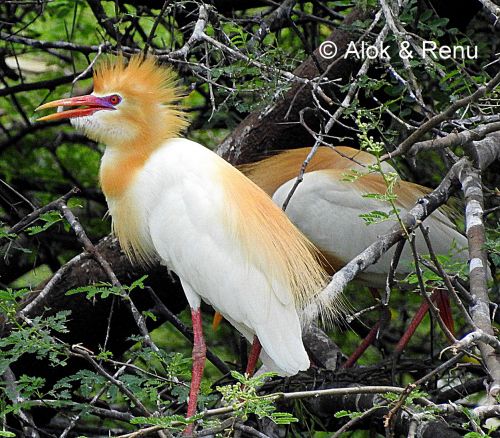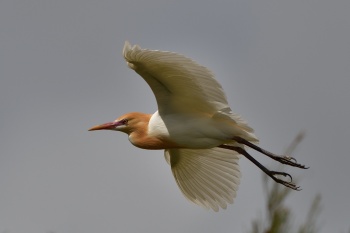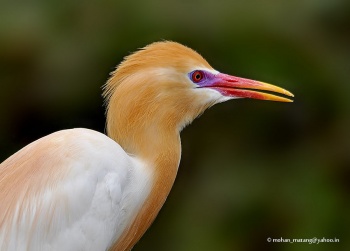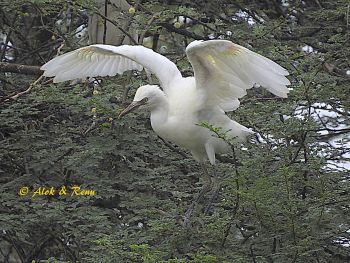
In a Mixed Heronry
Photo © by Alok Tewari
Keoladeo National Park, Bharatpur, Rajasthan, India, 23 July 2015
- Ardea coromanda
Bubulcus coromandus, Ardeola coromanda, Egretta coromanda
Identification
45-56 cm, males apparently larger (at least heavier) than females.
Basic plumages: in the younger birds entirely white, in the older birds may contains feather areas that become increasingly like breeding plumage as the year moves on: some of these birds may be indistinguishable in plumage from breeding Western Cattle Egret - but see similar species below.
Breeding plumage: cinnamon to tawny to rich orange on head (except narrow areas around bill and eye), neck, throat and breast to belly, and a collection of ornamental plumes from the mantle. Rest of plumage white.
Bare parts: most of the year, bill is yellow to orange-yellow, and especially in younger birds, with dusky tip. Lores yellow to yellow-green. Eyes are most often pale yellow but can be more orange locally, e.g., in Australia. Legs and feet often dark green (appearing blackish) with yellow soles. All of these change for a short period during high breeding to much brighter color, vinaceous orange in some parts to purple-pink in lores.

Photo © by Ken Doy
Lake Galletly, Gatton Campus, Queensland, 10 November 2017
Similar species
Compared with Western Cattle Egret, the Eastern species has longer legs and bill but shorter tail. The longer legs past the tail are especially noticeable in flight. In breeding, Eastern C.E. has much stronger coloration that covers a larger part of the bird, while birds in basic plumage cannot be distinguished by coloration. The overall size might also be larger or the way the bird holds itself may make it appear so.
Distribution
Found in Asia and Australasia: breeds throughout the Indian Subcontinent east to China and southern Japan and south to Indonesia, New Guinea and throughout Australia except the most arid interior. They also occur in New Zealand but seemingly only as winter visitors, breeding has not been observed.
Occurrences west of India, in Iran and the Arabian peninsula may only occur sporadically.
Taxonomy
This species was formerly included in a complex named Cattle Egret together with Western Cattle Egret.
Some sources place this species in genus Bubulcus
Subspecies
This is a monotypic species[1].
Habitat
Feeds at both wet and dry locations but mostly where large, grassing animals are found, while breeding takes place where other species have already established heronries.
Behaviour
This species is both migratory and dispersive. In northern Asia, the birds leave due to winter, in India, migration is due to wet vs dry seasons, and in Australia, they seem to leave the hotter areas when not breeding.
Diet
Feeding most often involves being near grassing, large animals and catching insects (and whichever other animals are available) scared up by the movement of these animals, but also involve other situations where especially insect food is easily and abundantly available.
Vocalisation
A large number of calls have been described; these are used at or near the breeding colony, it is usually silent away from there.
References
- Clements, J. F., P. C. Rasmussen, T. S. Schulenberg, M. J. Iliff, T. A. Fredericks, J. A. Gerbracht, D. Lepage, A. Spencer, S. M. Billerman, B. L. Sullivan, M. Smith, and C. L. Wood. 2024. The eBird/Clements checklist of Birds of the World: v2024. Downloaded from https://www.birds.cornell.edu/clementschecklist/download/
- Gill, F, D Donsker, and P Rasmussen (Eds). 2023. IOC World Bird List (v 13.2). Doi 10.14344/IOC.ML.13.2. http://www.worldbirdnames.org/
- Paper by Ross Ahmed describing the differences between Western and Eastern Cattle Egrets.
- Telfair II, R. C., P. Pyle, and R. Roshnath (2023). Eastern Cattle Egret (Bubulcus coromandus), version 1.0. In Birds of the World (B. K. Keeney and S. M. Billerman, Editors). Cornell Lab of Ornithology, Ithaca, NY, USA. https://doi.org/10.2173/bow.categr2.01
Recommended Citation
- BirdForum Opus contributors. (2025) Eastern Cattle Egret. In: BirdForum, the forum for wild birds and birding. Retrieved 16 May 2025 from https://www.birdforum.net/opus/Eastern_Cattle_Egret
External Links
GSearch checked for 2020 platform.1





